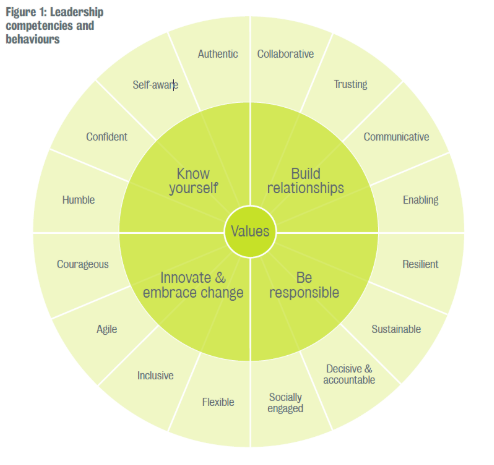In my post last month, I wrote about making a pledge to yourself to be the best leader you can be in 2019. According to this report, published by Arts Council England, whether you’re in a “leadership” position at your organization or not, basic leadership skills are required for every role in our industry. And if we are going to survive the challenges ahead of us, the current leadership model has to become one that is less hierarchical and more “facilitative, flat and diverse.” Your colleagues in current, traditional leadership roles will have to both accept and help guide this effort, but it’s incumbent upon us as individuals to be our own agent for change and growth.

The report included this graphic (pictured right) which illustrates four key leadership values and the essential behaviors associated with each one of them. In this post I will summarize each of these areas and share some ways you can get started with building the leader in you:
Know Yourself
Before you can lead, you have to be comfortable acknowledging your strengths and weaknesses. And not just admitting them, but owning them! With a sense of self-awareness comes confidence, which is a key trait for all leaders. This can only happen when you are open with both yourself and your colleagues about the things you’re good at, and the areas in which you could improve. One way to tackle this is to mentor others in your areas of strength, and conversely, actively seek guidance in your areas of weakness. Try making a list of these strengths and weaknesses, and then identify how you can specifically help others; and who can help you. While thinking about this, consider how your worldview might affect these revelations about yourself and how you might become more receptive to others’ views. This is vital to bringing increased diversity to our lives and work.
Build Relationships
Strong relationships exist where both parties agree to be more collaborative and more communicative. Work next year on increasing both the number of relationships you have as well as the depth of each relationship. The more numerous and deep your relationships, the more likely you are to build trust in others and leverage those collaborations to their fullest potential for you, your collaborators, and the arts. Join an advocacy group in your community, attend more networking events, or even comb through LinkedIn to find new people to share insight and goals with.
Embrace Change and Innovate
Humans are most comfortable when things are steady, stable, and predictable. Unfortunately, life isn’t really like that, and work in the arts tends to flourish when things are risky, new, and uncertain. But change and innovation don’t have to be filled with anxiety, and they won’t be if you’re actively embracing the two values above. The more you accept change as a constant, remain honest with yourself, and build collaborative relationships, the more the fear of change will dissipate as you gain trust in both yourself and your colleagues. Talk with your team about what changes you’d like to see at your organization and address any fears they might have right up front.
Be Responsible
More than just meeting your goals and deadlines, responsibility in leadership takes a much higher view. Practicing financial and environmental sustainability, prioritizing ethics and accountability, being socially engaged in your community (however you define that), and demonstrating resiliency throughout times of change and challenge are four areas where we could always improve. Before you make a decision on a particular change at your organization, run the impacts of that choice through these lenses to make sure it aligns in a positive way that moves you and your organization forward.
While these four values are ones most good humans try to embrace in general, applying them to the workplace is definitely a change for many organizations in our industry. As you strive to bring these changes to your work life, I’d encourage you to examine the ways in which doing so will help contribute to greater diversity. Not just diversity of backgrounds, but diversity of thought, programming, and audience as well. After all, if increased diversity is what we’re striving for, then the more voices involved in the process, the better. Good luck on your 2019 leadership journey!

